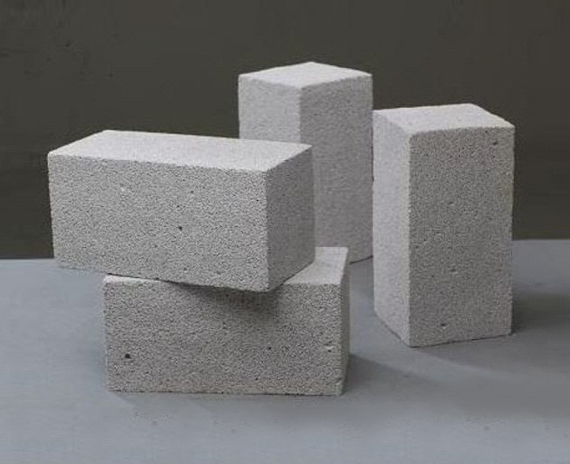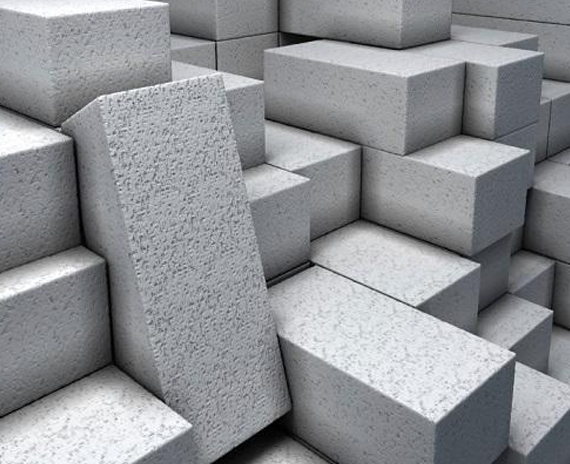Autoclaved Aerated lightweight Concrete
Cellular lightweight concrete blocks are the new favorite building material of the construction industry,
These blocks are lightweight, energy-efficient, fire-resistant and an excellent thermal insulator. The blocks are extremely lightweight and thus suitable for internal as well as external construction.
Aerated concrete blocks are ideal for all kind of structures such as schools, hospitals, hotels, offices, independent housing and apartments. The buildings constructed with AAC blocks are also known as environmentally friendly buildings and these buildings don’t require curing and plastering.
Cellular lightweight concrete blocks was developed in 1924 by a Swedish architect, who was looking for an alternate building material with properties similar to that of wood – good thermal insulation, solid structure and easy to work with.
Cellular lightweight concrete blocks are manufactured by recycling fly-ash. Fly ash is mixed with cement, lime, water and an aerating agent.
Autoclaved aerated lightweight concrete (AAC) is a type of lightweight concrete which is used to produce blocks and replace bricks. AAC is lighter than conventional concrete. It is formed by using Portland cement, fly ash, limestone, aluminum powder and water. Aerated concrete has a good strength, durability, good thermal and sound insulation. Dry density of this material ranging between 600 kg/m3 to 1600 kg/m3. Non autoclaved lightweight concrete blocks can be used for housing and commercial purposes.
A modern solution for better construction from a CHENNAI based company
The Autoclave Aerated Concrete Block, or more popularly, AAC Block is a happening, smart and green building material now widely used all over India. Made by a CHENNAI based company that’s always on the lookout for contemporary innovations in building materials, CELLOLITE AAC Block has emerged as the most preferred substitute and is fast replacing conventional Red Clay Bricks, Fly Ash Bricks, so on, which were used in building walls in residential, commercial and institutional construction until now.
A modern solution for better construction, Cellolite AAC Blocks comprise 60 – 65% Fly Ash (by weight), with other elements being OPC Cement, Quicklime, Aluminum powder With Such strong composition, no wonders Cellolite AAC Blocks are highly robust and durable despite their light weight. Also, this AAC Block’s solidity owes its origins to the calcium silicate and from the process of curing in a pressurized steam chamber called an Autoclave. But don’t autoclave, we do water & moisture curing as natural that’s why it is called as non autoclave aerated concrete.
AAC blocks Cost Saving & Benefits
Reduces overall construction cost by 30%
- AAC blocks are the best alternative to other building materials such as steel, cement and jelly.
- High-insulation blocks save up to 30% in energy costs. Reduces construction time by 20%
- Reduces operating cost by 30-40%
- No burning of fossil fuel (Coal)
- No emission of Carbon Di-Oxide (Co2)
- Steam cured cement blended blocks
- Superior thermal insulation of the blocks reduces the need to turn on the air conditioner which in turn helps in saving electricity costs.
- Reduces overall construction cost by 30% as it requires less jointing and reduces need for cement and steel.
- Helps in saving unnecessary labor costs
- Reduces overall labor and material costs
- The blocks maintain ecological stability
- No top soil cutting which saves precious land.
For What We Use AAC Blocks
- Energy saving
- Easy to install
- Less weight
- Endurance
- Precision
- Non toxic
- Thermal insulation
- Fire resistance
- Acoustic performance
- Moisture resistance
- Workability
- Cost saving
- Fast construction
- Water barrier
- Fire resistance
- Earthquake resistant
- Reduce plaster cost
- High strength
- Pest resistant
ADVANTAGES OF AAC BLOCKS
LOW COST & LITE WEIGHT
Cellolite AAC blocks are an affordable, cost-efficient and eco—friendly substitution for red clay bricks. It’s ideal for constructing edifices, thanks to its singular traits of high load bearing capacity and light weight mass. What’s more, Cellolite AAC blocks possess a well-defined porous structure and insulation property, when compared to other light-weight concrete materials. The presence of even air pockets ensures comparatively less weight in Cellolite AAC blocks, when compared with all other bricks in the market.
ACOUSTIC INSULATION (SOUND)
Cellolite AAC Blocks are unique and first-of-its-kind in its genre of building materials because they offer definitive work-ability, durability and suppleness along with sound insulation properties. The sound reduction index of the Cellolite AAC blocks are outstanding as per the global Sound Reduction Index that is used at international standards for evaluating the performance of acoustic properties of partition (wall) structure. The sounds in structures built with Cellolite AAC blocks get reflected due to its low sound absorption index of A0 and a very low sound transmission index of B3. This demonstrates the dissipation of sound traveling through Cellolite AAC and thus it will not transmit.
FIRE RESISTANT
Cellolite AAC blocks are reasonably effective against fire, and easily meet the rigorous requirements of fire safety — as they can resist fire up to 1200°C. The factional air pockets, within, augment thermal diffusion, to the tune of 60% of that of the clay brick. The impressive thermal insulation is able to hold out extremely hot/cold environments with flying colors. The energy efficiency is enhanced as the heating and cooling prerequisites of structures using Cellolite AAC blocks are very modest regardless of the ambient temperatures.
COST SAVING
Time consumed in building walls decreases due to light weight of the product and its size advantage over conventional all other t types of bricks. This decreases lead time as well as installation time
WATER SAVER
You would be surprised to know that water is not required for curing Cellolite AAC Blocks if Cellolite AAC Block jointing mortar is used. Only in the case of conventional mortar mix mortar joints that water is needed for curing.
ENERGY EFFICIENT
Thermal insulation is one of the greatest benefits of using Cellolite AAC Blocks, as Cellolite AAC walls help maintains distinct internal and external temperatures, saving energy cost.
NOISE RESISTANT
Noise reduction is essential in today’s chaotic city life. Thanks to the sound transmission class rating of 44, Cellolite AAC blocks can be used as a sound barrier of 8″ wall to shut out the hustle and bustle of urban roads.
NO WATER SEEPAGE AND MINIMAL ABSORPTION
The perpetual pores in Cellolite N-AAC blocks are unvaryingly spread all over each piece, resulting in minimal absorption owing to subdued Capillary action. This trait provides the Cellolite AAC blocks with no water seepage and minimal absorption performance
RESILIENCE
The compressive strength of Cellolite AAC blocks ranges around 3-4N/m2.
PEST/INSECT RESISTANT
Thanks to the absence of organic components in the Cellolite AAC blocks, an extraordinary resistance against common pests, rodents as well as moulds is ensured.
ENERGY EFFICIENCY
By definition, energy efficiency refers to usage of less energy to perform a task. Through thermal insulation, Cellolite AAC walls provide this benefit by helping maintain appropriate internal and external temperatures, thus saving vital energy and cost.
EARTHQUAKE RESISTANT
The manufacturing process gives the blocks considerable strength, this along with their light weight impart steadiness to a building, making it earthquake resistant..
WATER BLOCKADE
The continual pores in Cellolite AAC structure are uniformly spread all over the blocks leading to minimal absorption due to red used Capillary action. This property renders the Cellolite AAC blocks their brilliant anti- water seepage and absorption quality.
0% BREAKAGE
Since we have our unit located in Chennai itself, the breakage of blocks is 0%. The delivery is easier and quicker because of the unit being located close. This makes the entire set usable with no loss in the blocks…
QUICK-TO-ARRANGE
The large dimension of Cellolite AAC blocks considerably reduces the number of blocks and the time to arrange them while building as compared to the red bricks. This reduces the installation time to a great extent. Masonry required is also eased out and the end result is cost effective.
REDUCED PROJECT COSTS
Despite best efforts of the laborers, the conventional and other types of bricks cannot match the light weight and superior size of Cellolite AAC blocks. So with decreased lead and installation time, you can easily save on costs.
FASTER PROJECT COMPLETION
Unlike red bricks installation which is slow and tedious, Cellolite AAC blocks with enlarged dimension ensure faster building process and thus reduced project turnaround time. While the masonry work is brought down, a swift completion means built spaces can be sold or rented faster.
NO BREAKAGE FOR BUYERS/BUILDERS
There is no chance of breakage of AAC blocks for buyers of Chennai as Cellolite has a unit within the 35km from the city. Also, you can expect timely delivery of blocks with no loss, thanks to the favorable unit location.
CELLOLITE (N-AAC) Blocks come in the following standard sizes
Length |
Height |
Width (Thickness) |
| 600 mm | 200 mm | 100 mm |
| 600 mm | 200 mm | 150 mm |
| 600 mm | 200 mm | 200 mm |
| 600 mm | 200 mm | 230 mm |
Area coverage |
|||
| Sizes L x H x W | No of Blocks (Per CBM) | Area (Per Block In Sq.Ft.) | |
| 600 x 200 x 100 | 1m3 | 72 | 1.35 |
| 600 x 200 x 150 | 1m3 | 48 | 1.29 |
| 600 x 200 x 200 | 1m3 | 36 | 1.29 |
| 600 x 200 x 225 | 1m3 | 30 no’s + 6no’s – 4” | 1.29 |
AAC Blocks Comparison
Parameter |
AAC Block |
Concrete Block |
Clay Brick |
| Size (mm) | (600x200x100-300) | (400x200x100-200) | (230x115x75) |
| Variation in dimensions | +/-1mm | +/-3mm | +/-5mm |
| Compressive strength | 30 – 50 kg/cm2 | 40 – 50 kg/cm2 | 25 – 30 kg/cm2 |
| Dry Density | 550 – 700 kg/m3 | 1800 kg/m3 | 1950 Kg/m3 |
| Fire Resistance | 4 – 6 Hour’s Depending on thickness |
4 hours | 2 hour |
| Sound Reduction Index (dB) | 60 for 200 mm thick wall | 30 for 200 mm thick wall | 40 for 230 mm thick wall |
| Thermal Conductivity W/(K-m) |
0.122 | 0.51 | 0.81 |



